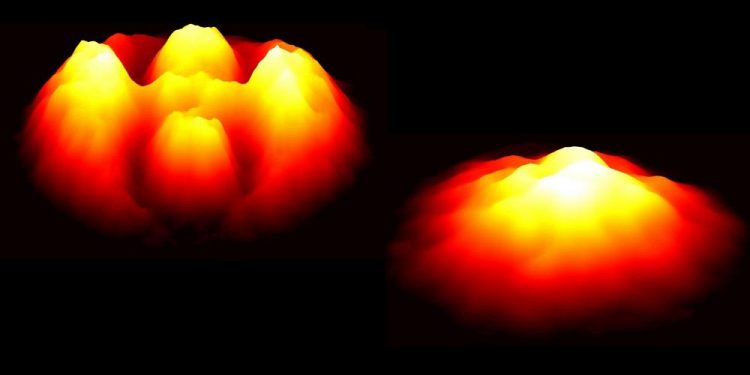Researchers watch quantum knots untie

Particle densities related to the decay of the quantum knot (left), which surprised researchers by untying itself after a few microseconds and eventually turning into the spin vortex, (right) Image credit: Tuomas Ollikainen/Aalto University
A quantum gas can be tied into knots using magnetic fields. Our researchers were the first to produce these knots as part of a collaboration between Aalto University and Amherst College, USA, and they have now studied how the knots behave over time.
The surprising result is that the knots untie themselves over a short period of time, before turning into a vortex.
The research was mainly carried out by Tuomas Ollikainen, a PhD student at Aalto university who split his time between carrying out experimental work in Amherst in Massachusetts, and analyzing the data and developing his theories at Aalto.
“We hadn't been able to study the dynamics of these sorts of three-dimensional structures experimentally before, so this is the first step to this direction.” says Ollikainen.
“The fact that the knot decays is surprising, since topological structures like quantum knots are typically exceptionally stable. It's also exciting for the field because our observation that a three-dimensional quantum defect decays into a one-dimensional defect hasn't been seen before in these quantum gas systems”
The researchers hope their new study opens up new avenues in experimental research. One of the key breakthroughs in the study was being able to have better control over the state of the quantum gas, which allowed them to detect changes in its structure, like the decay of the knots and the formation of the vortex.
“Of course one can simulate these things but actually making quantum knots is not that easy. By being able to control the environment better we can explore different effects and get to understand more about these exciting quantum systems.” tells Ollikainen.
“When we tied quantum knots in 2016, it was the first realization of three-dimensionally winding topological structures. That was like breathing air another planet for the first time. Amazing.” says Prof. Mikko Möttönen, head of Quantum Computing and Devices group where Ollikainen works.
“I know that many researchers have paid attention to our work and got inspiration to try this out in completely different type of systems. It would be great to see this technology being used some day in a practical application, which may well happen. Our latest results show that while quantum knots in atomic gases are exciting, you need to be quick to use them before they untie themselves. Thus the first applications are likely to be found in other systems.” Möttönen continues.
###
The Quantum Computing and Devices group is a part of QTF, the Academy of Finland Centre of Excellence for Quantum Technology. The research benefitted from the computational resources from CSC-IT Center for Science Ltd. and Aalto Science-IT project.
Media Contact
All latest news from the category: Physics and Astronomy
This area deals with the fundamental laws and building blocks of nature and how they interact, the properties and the behavior of matter, and research into space and time and their structures.
innovations-report provides in-depth reports and articles on subjects such as astrophysics, laser technologies, nuclear, quantum, particle and solid-state physics, nanotechnologies, planetary research and findings (Mars, Venus) and developments related to the Hubble Telescope.
Newest articles

A universal framework for spatial biology
SpatialData is a freely accessible tool to unify and integrate data from different omics technologies accounting for spatial information, which can provide holistic insights into health and disease. Biological processes…

How complex biological processes arise
A $20 million grant from the U.S. National Science Foundation (NSF) will support the establishment and operation of the National Synthesis Center for Emergence in the Molecular and Cellular Sciences (NCEMS) at…

Airborne single-photon lidar system achieves high-resolution 3D imaging
Compact, low-power system opens doors for photon-efficient drone and satellite-based environmental monitoring and mapping. Researchers have developed a compact and lightweight single-photon airborne lidar system that can acquire high-resolution 3D…





















